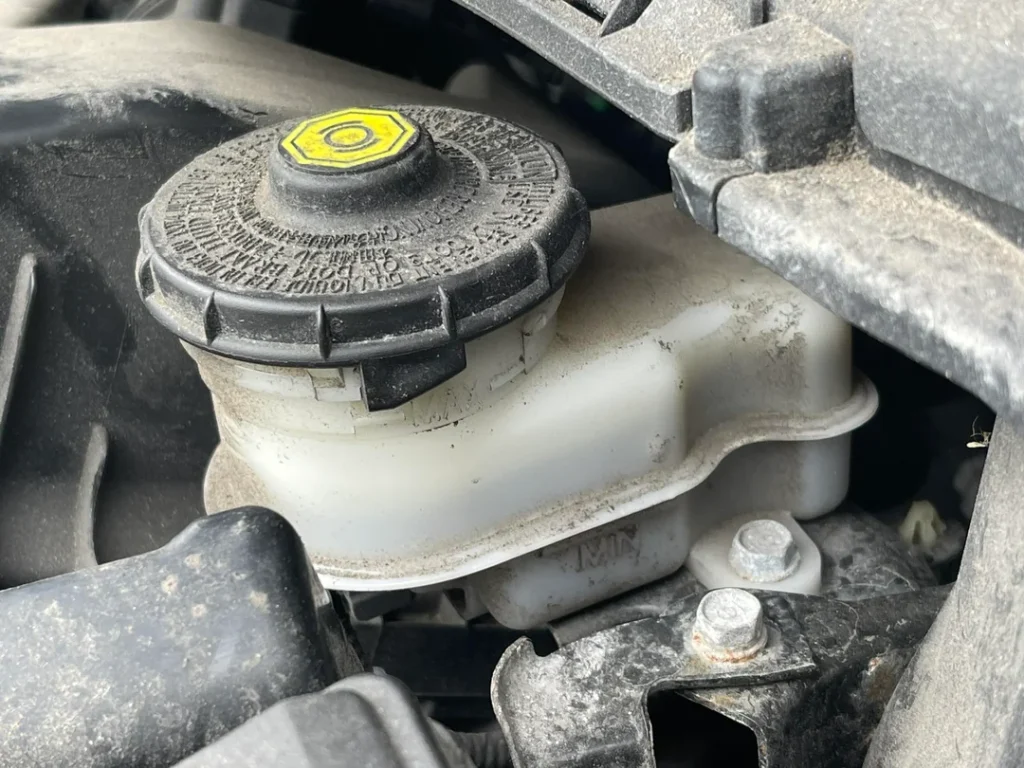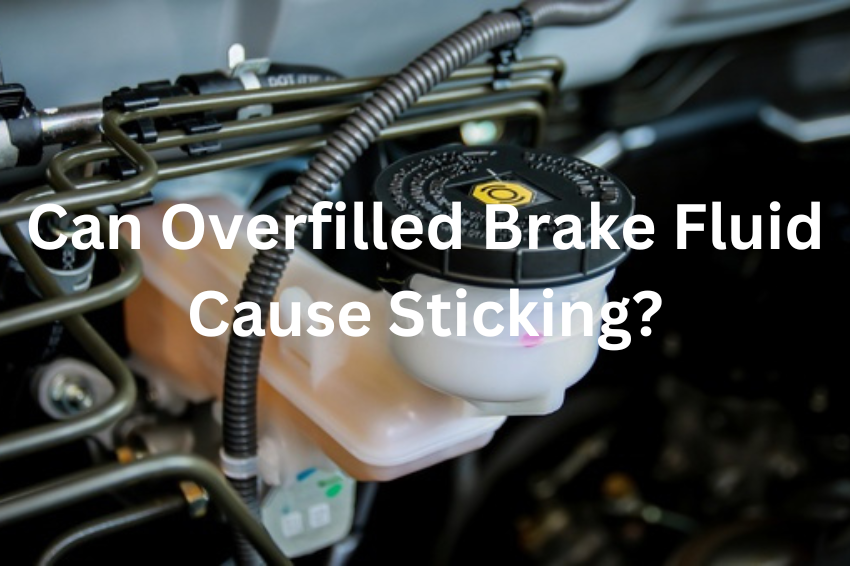“Yes, overfilled brake fluid can definitely cause your brakes to stick. Brake fluid transmits pressure from the brake pedal to the calipers, which clamp the brake pads onto the rotors to slow down the wheels. When the system is crammed with too much fluid, it can prevent the pistons in the calipers from fully retracting when you release the brake pedal. This constant pressure keeps the brake pads partially engaged with the rotors, resulting in that sticky feeling and potentially reduced braking performance.”
Is It Dangerous To Drive With Brakes That Are Sticking?
Yes, driving with sticking brakes is absolutely dangerous and should not be attempted.
When brakes stick, they don’t fully disengage from the wheels, particularly reducing your ability to stop the car effectively.
This can lead to several critical situations on the road, putting you and others at risk.
Here’s why sticking brakes are a safety concern:
- Increased Stopping Distances: The most immediate danger is the inability to stop your car on time. Sticking brakes creates friction even when you’re not pressing the pedal, essentially keeping the brakes partially applied. This extra friction can greatly extend your stopping distance, especially at higher speeds. Imagine needing to make a sudden stop for a red light or an unexpected obstacle. With sticking brakes, the increased stopping distance could lead to a rear-end collision.
- Difficulty Maintaining Control: Sticking brakes can make it harder to steer and maneuver the vehicle, especially during emergencies. This is because the uneven braking force on each wheel can pull the car in one direction, making it difficult to maintain control. This can be particularly dangerous when trying to navigate sharp corners, avoid sudden hazards, or during bad weather conditions where roads might be slippery.
- Potential Brake Failure: In severe cases, especially if the sticking brakes are not addressed promptly, the brakes could completely lock up, causing a loss of control over the vehicle. This scenario is more common with older vehicles or those without Anti-Lock Braking Systems (ABS). A complete brake lockup can lead to a skidding situation, making it nearly impossible to steer and significantly increasing the risk of an accident.
What Are The Symptoms Of Overfilled Brake Fluid?
While brake fluid is essential for proper braking performance, having too much can actually cause problems.
Here’s how to identify the symptoms of overfilled brake fluid:
- Spongy Brake Pedal: One of the most noticeable signs of overfilled brake fluid is a soft or mushy feeling when you press the brake pedal. Normally, a brake pedal should provide a firm and responsive feel. If it feels spongy or requires extra pressure to engage the brakes, it could be because the excess fluid is preventing the pistons in the calipers from creating the necessary pressure to clamp the brake pads firmly onto the rotors.
- Increased Stopping Distance: If you find it takes significantly longer than usual to bring your car to a complete stop, overfilled brake fluid could be a reason why. The extra fluid can cause the brake pads to maintain slight contact with the rotors even when you’re not pressing the pedal. This constant drag reduces their effectiveness, leading to increased stopping distances. Imagine needing to make a sudden stop for a red light or an unexpected obstacle. With overfilled brake fluid, the extra distance needed to come to a complete stop could increase the risk of a collision.
- Unusual Noises: Grinding or scraping noises while braking can sometimes be a sign of overfilled brake fluid putting excessive pressure on the brake components. This is more common with drum brakes, where the constant pressure can cause the brake shoes to rub against the drum excessively. Disc brakes, on the other hand, may exhibit a squealing noise due to similar pressure imbalances.
- Sticking Brakes: In severe cases, overfilled brake fluid can lead to a situation where the brakes become partially engaged and stick. This can manifest as difficulty fully releasing the brake pedal or feeling a dragging sensation while driving. This is because the extra fluid keeps the pistons in the calipers extended, preventing the brake pads from fully retracting from the rotors.
While these symptoms can point towards overfilled brake fluid, they can also be caused by other underlying brake system issues.
If you experience any of these signs, it’s crucial to consult a qualified mechanic as soon as possible.
They can diagnose the root cause of the problem and perform any necessary repairs to ensure your brakes are functioning properly.
How To Fix Brakes That Are Sticking Due To Too Much Fluid?
Attempting repairs yourself can be risky if you’re not comfortable with basic car maintenance.
In most cases, I strongly recommended to consult a qualified mechanic to diagnose the problem and fix your brakes.
They have the expertise and tools to safely address the issue and ensure your brakes are functioning properly, getting you back on the road with confidence.
Brake systems can be complex, and even minor mistakes during repairs can lead to serious consequences.
For instance, removing too much brake fluid can introduce air bubbles into the system, which can significantly compromise braking performance.
Additionally, some repairs may require specialized tools or knowledge beyond the scope of basic car maintenance.
With that said,
If you are comfortable with basic car maintenance and understand the risks involved, here’s a simplified explanation of how to potentially address sticking brakes caused by overfilled fluid.
Tip: Before attempting any DIY procedures, prioritize your safety. Always wear safety glasses and gloves when working with brake fluid, as it can be harmful to your eyes and skin. It’s also important to consult your car’s manual for specific instructions and brake fluid reservoir location for your vehicle.
To remove Excess Fluid:
- Gather the Tools: You’ll need a turkey baster or a dedicated brake fluid bleeder tool, a clean rag, and a container to collect the waste fluid.
- Carefully Remove Fluid: Never open brake fluid by mouth. Using the baster or bleeder tool, slowly remove small amounts of fluid at a time from the brake reservoir. Avoid over-draining, as this can introduce air bubbles.
- Monitor and Adjust: After removing a small amount of fluid, check if the sticking sensation has improved. Test the brake pedal feel and repeat the process of removing small amounts of fluid in combination with test drives until the sticking is resolved and the pedal feels firm.
- Refill and Disposal: If needed, you can top up the reservoir with fresh brake fluid of the same type recommended by your car’s manual. Never reuse old brake fluid, and dispose of the waste fluid responsibly according to local regulations.
How Do I Check My Brake Fluid Level Correctly?
Here’s a guide to help you check your brake fluid level correctly:
For the most accurate reading, it’s important to park your car on a level surface before checking the brake fluid level.
An uneven surface can cause the fluid to settle in one area, giving you a false reading.
Step-by-Step Guide:
- Locate the Brake Fluid Reservoir: Pop the hood of your car and find the brake fluid reservoir. It typically looks like a translucent plastic container with a black screw-on cap. The cap will often have a symbol related to brake fluid, sometimes an exclamation mark enclosed in a circle. If you have trouble finding it, consult your car’s owner’s manual for specific instructions on locating the reservoir for your vehicle make and model.

- Checking the Fluid Level: Most modern cars have a translucent reservoir with easy-to-read MIN and MAX fill lines printed on the side. With the hood open, simply take a look at the reservoir. The fluid level should be somewhere between these MIN and MAX markings. If your car is older and has a metal reservoir with a dipstick instead, you’ll need to remove the cap and wipe the dipstick clean with a rag. Then, reinsert the dipstick fully and remove it again to check the fluid level against the markings on the dipstick itself.

- Color and Clarity: While you’re checking the level, take a moment to observe the color and clarity of the brake fluid. Fresh brake fluid is usually light golden or amber-colored. If the fluid appears dark brown or murky, it could be a sign of aged fluid or overheating within the system. In these cases, it may be time for a brake fluid flush, which is a service best performed by a qualified mechanic.
Here’s a video guide on how you can check your Brake fluid:
Reference Sources:
